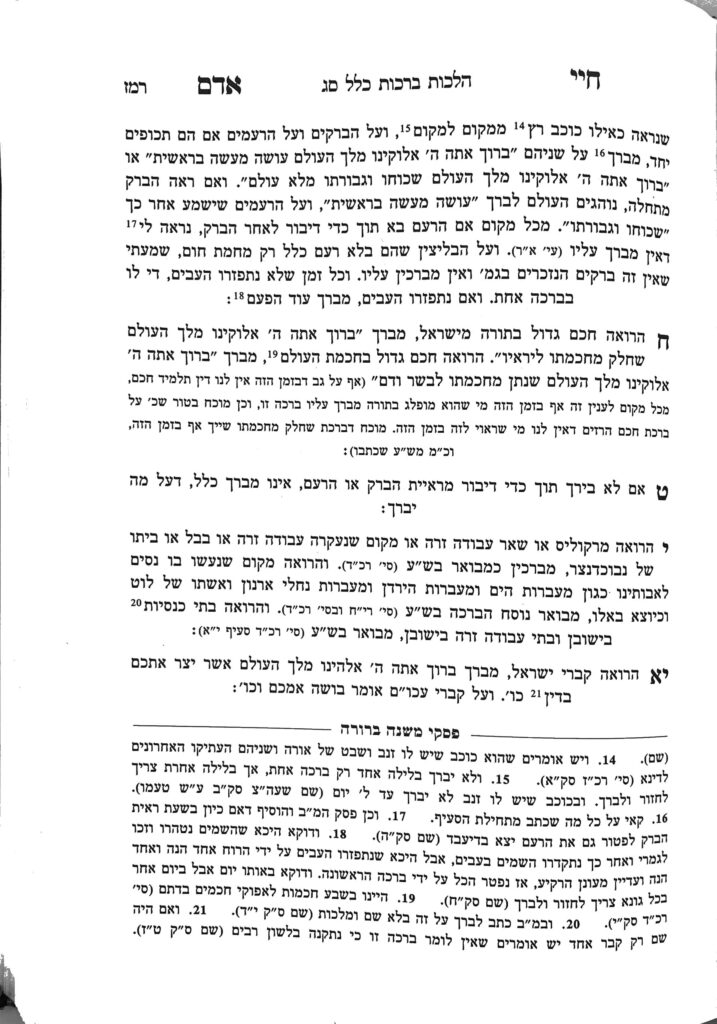We are continuing in siman 10 with the bracha of asher yotzar eschem badin. We left off with a question regarding whether one should make the bracha on a second cemetery within 30 days of having already made the bracha on a different cemetery. Similarly, this question is relevant to the same cemetery in which more than one grave was added since first making the bracha.
The Mishnah Berurah suggests that one should not make the bracha. However, Rav Ovadia Yosef ztl is quoted as holding that one can make the bracha on a different cemetery. He explains that there are opinions that one can make the bracha on the same cemetery if new graves have been added, so certainly one can make the bracha on a new cemetery. The minhag of the contemporary Sephardi poskim is to follow Rav Ovadiah, but the Ashkenazi minhag is not to make the bracha.
We will discuss a few halachos regarding the bracha of asher yotzar eschem badin:
- A person makes the bracha even if they do not walk into the cemetery, but just pass by it, as long as they see the kevarim.
- The bracha can be said on Shabbos, because the bracha is not related to aveilus.
- The bracha can be made within four amos of a kever, and it is not a problem of loeig l’rash (the issur to perform mitzvos or learn torah in front of a niftar), because making the bracha is considered a tzorech hameis, for the benefit of the niftar. Similarly, a hesped can be delivered within four amos of the meis, even if the maspid quotes pesukim and the like, because it is considered a tzorech hameis.
At the time of a kevurah, aveilim do not make the bracha on their way into the cemetery, because they still have the status of an onein until the kevurah is complete. By the time the kevurah is complete, although an aveil can make brachos again, they have already seen the kevarim, so they do not make it.
Regarding those joining for the levaya, while they are in the process of the kevurah, they are busy with one mitzvah, and we have a rule that oseik b’mitzvah patur min hamitzvah, one is exempt from performing a second mitzvah while they are already engaged in a first mitzvah. Therefore, the minhag is not to make the bracha until after the kevurah. However, if one is able to make the bracha before the kevurah in a way which does not impede the kevurah, they may do so if they wish. Recently, this seems to have become the minhag.
If a person is going on a trip to visit kivrei tzadikim or family members in multiple cemeteries, they should make a bracha on the first cemetery and have in mind that it should cover all subsequent kevarim. This suggestion works even according to Rav Ovadiah.
Places such as Me’aras Hamachpela, where it is not entirely clear that the kevarim are precisely in that location, do not receive the bracha. When visiting mekomos where only one person is buried (Kever Rachel, Shmuel Hanavi, etc.) no bracha is said, because the bracha is only recited on more than one kever, as we learned earlier.
Summary
- If one sees a second cemetery within 30 days of a first, or if they return to the first cemetery and new kevarim have been added, the Sephardi minhag is to make the bracha again, and the Ashkenazi minhag is not to make the bracha.
- The bracha of asher yotzar eschem badin can be made even if one just passes by a cemetery, and even on shabbos.
- The bracha can be made within four amos of a kever.
- Aveilim do not make the bracha, but those joining for the kevurah should make the bracha after the kevurah is finished.
- If one is planning to visit multiple cemeteries, they can make one bracha on the first cemetery and have in mind that it cover all subsequent cemeteries.



